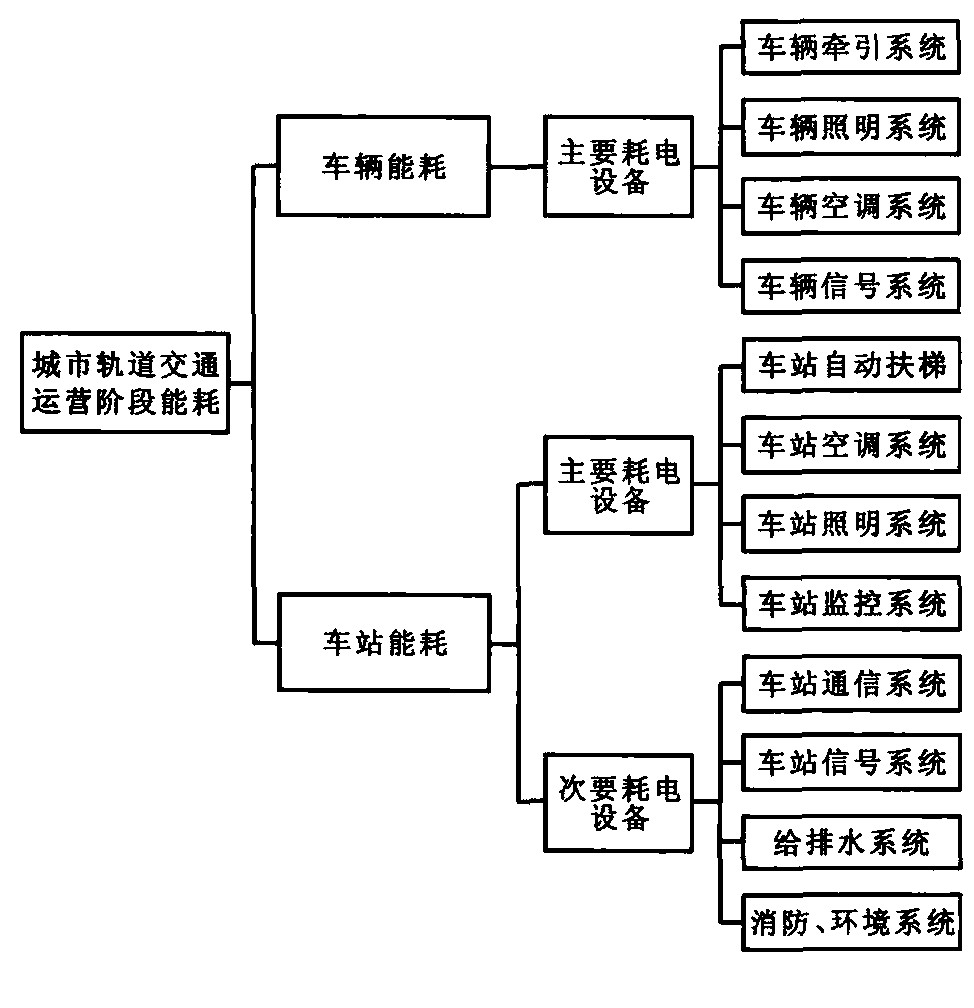Calculation method of whole life-cycle energy consumption for urban rail transit
-
摘要: 基于全寿命周期理论和城市轨道交通系统的特点, 提出了城市轨道交通全寿命周期能耗概念, 将全寿命周期划分为规划设计阶段、运营装备及建材生产阶段、施工建设阶段、运营维护阶段和报废拆除及处置5个阶段, 建立了5个阶段的能耗数学模型, 并对北方某大城市轨道交通5号线进行定量分析, 计算其全寿命周期总能耗与各个阶段能耗。计算结果表明: 在全寿命周期中, 上述5个阶段的能耗比重依次为0.004%、24.391%、3.884%、68.613%和3.108%, 运营维护阶段能耗最大, 是全寿命周期能耗控制重点, 运营装备及建材生产阶段能耗次之, 绿色节能材料的使用对降低能耗具有重要作用。Abstract: Based on the whole life-cycle theory and the characteristics of urban rail transit, the concept of whole life-cycle energy consumption was proposed, and the whole life-cycle of urban rail transit was divided into five stages, including plan and design stage, equipment and material production stage, construction stage, operation and maintenance stage, demolition and disposition stage.The mathematical models of energy consumption for 5 stages were set up, the energy consumption of No.5 rail transit line in a northern big city of China was quantitatively analyzed by using the mathematical models, and the total energy consumption of whole life-cycle and the energy consumption in every stage were calculated.Calculation result shows that the energy consumption proportions at the five stages are 0.004%, 24.391%, 3.884%, 68.613%and 3.108%successively during whole life-cycle.The energy consumption of operation and maintenance stage is biggest, so the operation and maintenance stage is the key point of energy consumption control.The energy consumption of equipment and material production stage is the second biggest, the use of green energy saving materials can play an important role in reducing energy consumption.
-
表 1 能源消耗情况
Table 1. Energy consumption condition

表 2 运营装备的寿命周期
Table 2. Life-cycles of operating equipments

表 3 不同运输方式的单位能耗
Table 3. Unit energy consumptions of different transportation methods

表 4 主要工程数量
Table 4. Main project quantities

表 5 主要材料消耗量
Table 5. Main material consumption quantities

表 6 客运量
Table 6. Passenger transportation volumes

表 7 分阶段能耗
Table 7. Energy consumption for every stage

-
[1] 陈进杰, 陈峰, 梁青槐, 等. 城市轨道交通全寿命周期成本分析[J]. 交通运输工程学报, 2010, 10(1): 82-87. doi: 10.3969/j.issn.1671-1637.2010.01.015CHEN Jin-jie, CHEN Feng, LIANG Qing-huai, et al. Whole life-cycle cost analysis of urban rail transit[J]. Journal of Traffic and Transportation Engineering, 2010, 10(1): 82-87. (in Chinese). doi: 10.3969/j.issn.1671-1637.2010.01.015 [2] ADALBERT H K. Energy use during the life cycle of single unit dwellings: examples[J]. Building and Environment, 1997, 32(4): 321-329. doi: 10.1016/S0360-1323(96)00069-8 [3] RAMESH T, PRAKASH R, SHUKLA K K. Life cycle energy analysis of buildings: an overview[J]. Energy and Buildings, 2010, 42(12): 1592-1600. [4] 冯建学. 基于全寿命周期能耗理论的建筑节能战略研究[D]. 天津: 天津理工大学, 2007.FENG Jian-xue. Research on the building energy saving strategy of China based life-cycle energy analysis[D]. Tianjin: Tianjin University of Technology, 2007. (in Chinese). [5] 朱嬿, 陈莹. 住宅建筑生命周期能耗及环境排放案例[J]. 清华大学学报: 自然科学版, 2010, 50(3): 330-334. https://www.cnki.com.cn/Article/CJFDTOTAL-QHXB201003001.htmZHU Yan, CHEN Ying. Cases for life-cycle energy consumption and environmental emissions in residential buildings[J]. Journal of Tsinghua University: Scienence and Technology, 2010, 50(3): 330-334. (in Chinese). https://www.cnki.com.cn/Article/CJFDTOTAL-QHXB201003001.htm [6] 陈莹, 朱赡. 住宅建筑生命周期能耗及环境排放模型[J]. 清华大学学报: 自然科学版, 2010, 50(3): 325-329. https://www.cnki.com.cn/Article/CJFDTOTAL-QHXB201003000.htmCHEN Ying, ZHU Yan. Models for life-cycle energy consumption and environmental emissions in residential buildings[J]. Journal of Tsinghua University: Scienence and Technology, 2010, 50(3): 325-329. (in Chinese). https://www.cnki.com.cn/Article/CJFDTOTAL-QHXB201003000.htm [7] 张燕燕. 城市轨道交通系统牵引及车站能耗研究[D]. 北京: 北京交通大学, 2008.ZHANG Yan-yan. Study on the power consumption of traction and station of urban rail transit[D]. Beijing: Beijing Jiaotong University, 2008. (in Chinese). [8] 杨臻明, 岳继光, 王晓保, 等. 基于回归模型的城市轨道交通能耗预测城市轨道交通研究[J]. 城市轨道交通研究, 2010, 13(12): 22-25. https://www.cnki.com.cn/Article/CJFDTOTAL-GDJT201012010.htmYANG Zhen-ming, YUE Ji-guang, WANG Xiao-bao, et al. Prediction of urban rail transit power consumption based on regression model[J]. Urban Mass Transit, 2010, 13(12): 22-25. (in Chinese). https://www.cnki.com.cn/Article/CJFDTOTAL-GDJT201012010.htm [9] 穆广友, 李晓龙, 尹力明. 等. 地铁车站照明系统能耗分析及节能对策[J]. 城市轨道交通研究, 2010, 13(8): 35-39. https://www.cnki.com.cn/Article/CJFDTOTAL-GDJT201008014.htmMU Guang-you, LI Xiao-long, YIN Li-ming, et al. Energy consumption and energy-saving of lighting system at subway stations[J]. Urban Mass Transit, 2010, 13(8): 35-39. (in Chinese). https://www.cnki.com.cn/Article/CJFDTOTAL-GDJT201008014.htm [10] 王玉明. 城市轨道交通系统能耗影响因素的量化分析[D]. 北京: 北京交通大学, 2011.WANG Yu-ming. Quantification analysis on the energy factors of the urban rail transit system[D]. Beijing: Beijing Jiaotong University, 2011. (in Chinese). [11] 陈爱侠, 关卫省, 陈宽民. 轨道交通建设对城市生态环境影响分析——以西安市城市轨道交通2号线为例[J]. 安全与环境学报, 2007, 7(3): 68-71. https://www.cnki.com.cn/Article/CJFDTOTAL-AQHJ200703017.htmCHEN Ai-xia, GUAN Wei-sheng, CHEN Kuan-mia. Analysis of impact of subway transit construction on urban eco-environment—taking Xi'an Urban Rail Transit Second Line as a sample[J]. Journal of Safety and Environment, 2007, 7(3): 68-71. (in Chinese) https://www.cnki.com.cn/Article/CJFDTOTAL-AQHJ200703017.htm [12] 陈伟珂, 罗方. 基于全生命周期理论的建筑能耗问题研究[J]. 建筑科学, 2008, 24(10): 23-27. https://www.cnki.com.cn/Article/CJFDTOTAL-JZKX200810007.htmCHEN Wet-ke, LUO Fang. Research on building energy consumption based on whole life cycle theory[J]. Building Science, 2008, 24(10): 23-27. (in Chinese). https://www.cnki.com.cn/Article/CJFDTOTAL-JZKX200810007.htm [13] 黄志甲. 建筑物能量系统生命周期评价模型与案例研究[D]. 上海: 同济大学, 2003.HUANG Zhi-jia. The model and case study of the life cycle assessment of building energy systems[D]. Shanghai; Tongji University, 2003. (in Chinese). [14] 仲平. 建筑生命周期能源消耗及其环境影响研究[D]. 成都: 四川大学, 2005.ZHONG Ping. Study of building life-cycle energy use and relevant environmental impacts[D]. Chengdu: Sichuan University, 2005. (in Chinese). [15] YOHANIS Y G, NORTON B. Life-cycle operational and embodied energy for a genetic single-storey office building in the UK[J]. Energy, 2000, 25(12): 1137-1148. [16] 顾道金, 朱颖心, 谷立静. 中国建筑环境影响的生命周期评价[J]. 清华大学学报: 自然科学版, 2006, 46(12): 1953-1956. https://www.cnki.com.cn/Article/CJFDTOTAL-QHXB200612001.htmGU Dao-jin, ZHU Ying-xin, GU Li-jing. Life cycle assessment for China building environment impacts[J]. Journal of Tsinghua University: Science and Technology, 2006, 46(12): 1953-1956. (in Chinese). https://www.cnki.com.cn/Article/CJFDTOTAL-QHXB200612001.htm [17] 王子甲, 陈峰, 施仲衡. 北京城市轨道交通中远期能耗预测研究[J]. 中国铁道科学, 2013. https://www.cnki.com.cn/Article/CJFDTOTAL-ZGTK201303023.htm34(3): 133-136. WANG Zi-jia, CHEN Feng, SHI Zhong-heng. Prediction on medium and long term energy consumption of urban rail transit network in Beijing[J]. China Railway Science, 2013, 34(3): 133-136. (in Chinese). https://www.cnki.com.cn/Article/CJFDTOTAL-ZGTK201303023.htm [18] 袁宏伟, 孔令洋. 城市轨道交通能耗影响因素及测算研究[J]. 都市快轨交通, 2012, 25(2): 41-44, 73. https://www.cnki.com.cn/Article/CJFDTOTAL-DSKG201202014.htmYUAN Hong-wei, KONG Ling-yang. Study and calculation of influencing factors on urban rail transit energy consumption[J]. Urban Rapid Rail Transit, 2012, 25(2): 41-44, 73. (in Chinese). https://www.cnki.com.cn/Article/CJFDTOTAL-DSKG201202014.htm [19] 龙江英. 城市交通体系碳排放测评模型及优化方法[D]. 武汉: 华中科技大学, 2012.LONG Jiang-ying. Evaluation model and optimization method of urban passenger transport system based on carbon emission target[D]. Wuhan: Huazhong University of Science and Technology, 2012. (in Chinese). [20] 陈涛. 高速列车运行能耗测算方法及其影响因素量化分析[D]. 北京: 北京交通大学, 2011.CHEN Tao. Traction energy consumption measuring methods study and quantification analysis on energy impact factors of high-speed train[D]. Beijing: Beijing Jiaotong University, 2011. (in Chinese). [21] 柏赞. 毛保华, 周方明, 等. 基于功耗分析的货物列车节能运行控制方法研究[J]. 交通运输系统工程与信息, 2009, 9(3): 43-50. https://www.cnki.com.cn/Article/CJFDTOTAL-YSXT200903008.htmBAI Yun, MAO Bao-hua, ZHOU Fang-ming, et al. Energy-efficient driving strategy for freight trains based on power consumption analysis[J]. Journal of Transportation Systems Engineering and Information Technology, 2009, 9(3): 43-50. (in Chinese). https://www.cnki.com.cn/Article/CJFDTOTAL-YSXT200903008.htm [22] LIAO Fei-xiong, ARENTZE T, TIMMERMANS H. Multistate supernetworks: recent progress and prospects[J]. Journal of Traffic and Transportation Engineering: English Edition, 2014, 1(1): 13-27. [23] 宋新启. 地铁能源管理系统设计[J]. 城市轨道交通研究, 2012, 15(12): 24-26. https://www.cnki.com.cn/Article/CJFDTOTAL-DSKG200904010.htmSONG Xin-qi. Design of electric energy management system of subway stations[J]. Urban Mass Transit, 2012, 15(12): 24-26. (in Chinese). https://www.cnki.com.cn/Article/CJFDTOTAL-DSKG200904010.htm [24] SEMEIDA A M. Derivation of travel demand forecasting models for low population areas: the case of Port Said Governorate, North East Egypt[J]. Journal of Traffic and Transportation Engineering: English Edition, 2014, 1(3): 196-208. [25] 孔令洋, 梁青槐, 张岩, 等. 直线电机轮轨交通系统牵引能耗研究[J]. 铁道学报, 2007, 29(6): 106-112. https://www.cnki.com.cn/Article/CJFDTOTAL-TDXB200706023.htmKONG Ling-yang, LIANG Qing-huai, ZHANG Yan, et al. Study on traction energy consumption of linear induction motor rail transit system[J]. Journal of the China Railway Society, 2007, 29(6): 106-112. (in Chinese). https://www.cnki.com.cn/Article/CJFDTOTAL-TDXB200706023.htm -





 下载:
下载:


